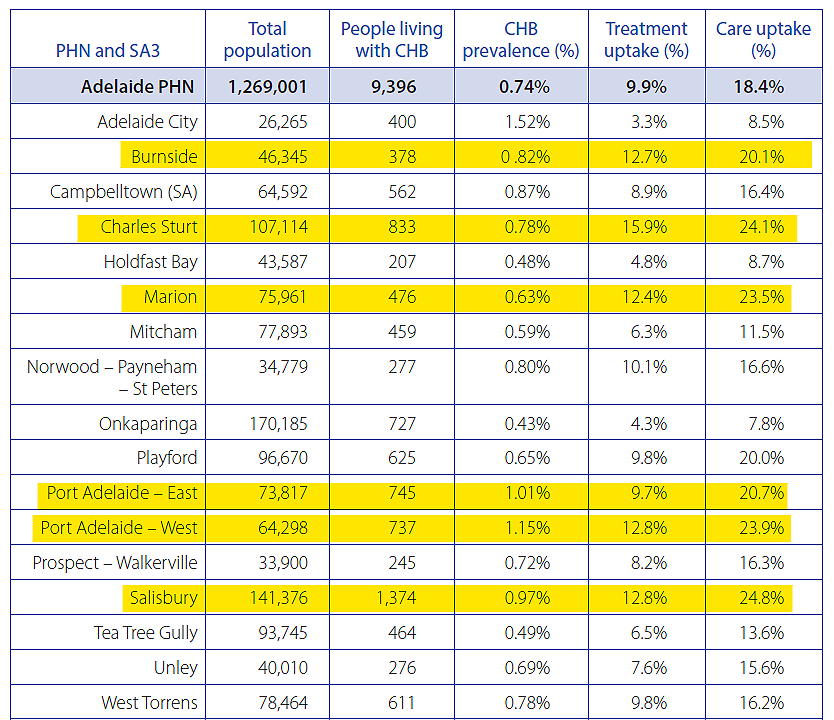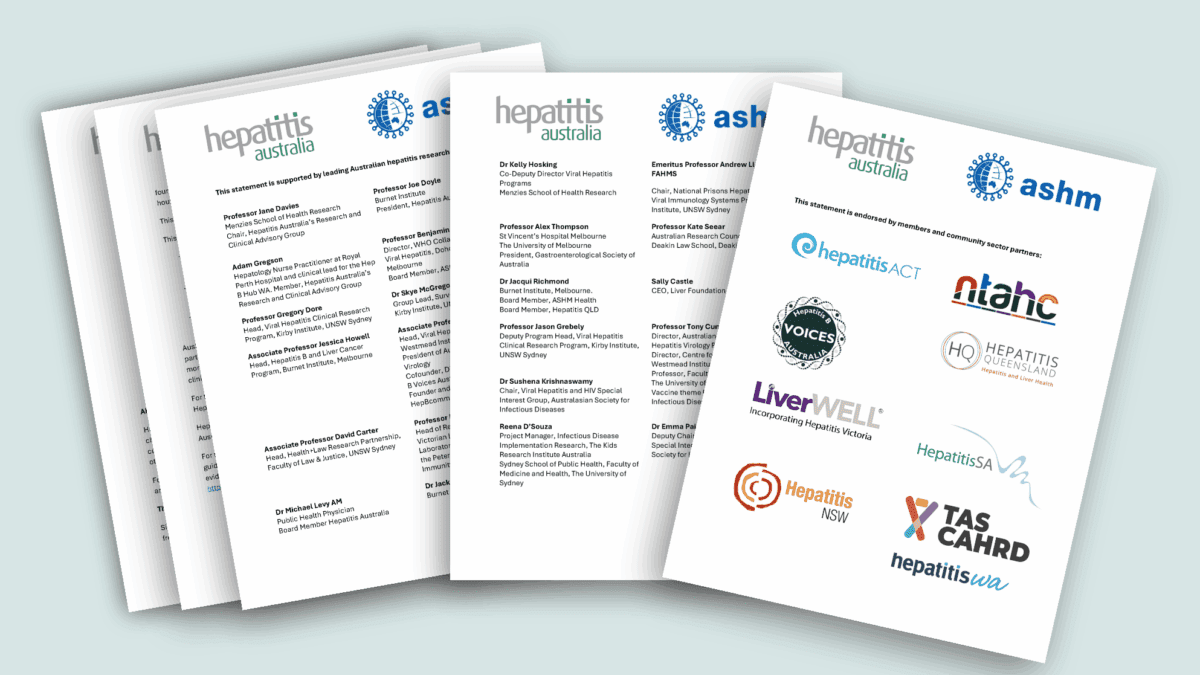Australia still has a long way to go to achieve its National Hepatitis B Strategy targets aimed at eliminating the disease by 2030.
The latest report from the Doherty Institute’s Viral Hepatitis Mapping Project reports that while overall infant immunisation reached the national target of 95% by 2020, coverage was low among Aboriginal and Torres Strait Islander children. Overall treatment uptake for chronic hepatitis B (CHB) is only half the 2020 target of 20% and for chronic hepatitis B care (i.e. treatment or monitoring), is less than half the targeted 50%.
Nation-wide, uptake of treatment and care in both hepatitis B declined in 2020. This was not an unexpected result in light of the COVID-19 pandemic. Regions which saw the greatest declines in treatment uptake were Central and Eastern Sydney, Hunter New England and Central Coast, Country SA, and Western Sydney. Regions where monitoring uptake reduced the most were Murrumbidgee, South Eastern Melbourne, Eastern Melbourne and North Western Melbourne.
Northern Territory
With only a year left, how close can we get to achieving those goals? At the launch of the 2020 Viral Hepatitis Mapping Report this week, the Northern Territory was identified as an example the rest of the country could look at.
Uptake of hepatitis B treatment and care in the Northern Territory (NT) made huge strides between 2016 and 2020. Hepatitis B treatment uptake rose from less than half the national average in 2016 to just below national average in 2020, and the Northern Territory’s hepatitis B care uptake at 24.8% is above the national average (22.6%).
According to the report’s lead author, Dr Jennifer MacLachlan, as well as other participants at the launch, this achievement was the result of long-term planning and effort, and working with people on the ground to find solutions that are culturally friendly and accessible for communities.
Encouragingly, ten of Australia’s 324 Statistical Areas 3s* have already reached the 2022 treatment target of 20% and three have reached the national target of 50% care uptake. (See charts below.)
2020 Hepatitis B Treatment Uptake – Top Regions

2020 Hepatitis B Care Uptake – Top Regions

South Australia
South Australia ranks fifth (8.8%) in hepatitis B treatment uptake and seventh (16.7%) in care uptake out of the eight states and territories. The Adelaide Primary Health Network (PHN) had a treatment uptake of 9.9% and a care uptake of 18.4%. Uptake in sub-areas Charles Sturt, Port Adelaide-West, Port Adelaide-East, Burnside, Marion and Salisbury were among the highest in the PHN. (See chart below).
Despite this, in a number of these higher-uptake areas, the number of people starting treatment dropped during 2020, in contrast to previous years where new treatment uptakes were increasing.

According to the Report, Australia’s National Hepatitis B Strategy (2018–2022) targets include:
- 80% of people living with CHB diagnosed
- 50% of people living with CHB engaged in care
- 20% of people living with CHB receiving treatment.
Overall, an estimated 8.6% of the Australian population live with chronic hepatitis B. Rates by regions vary, ranging from 1.84% of the population in the Northern Territory to 0.28% in Tasmania Other regions of higher prevalence include South Western Sydney (1.33%), Central and Eastern Sydney (1.33%), Western Sydney (1.25%) and North Western Melbourne (1.23%). The prevalence rate in Adelaide is 0.74% and in Country South Australia 0.42%.
Testing
Testing for hepatitis fell by 15% in 2020 in contrast to increases in previous years. Reductions most marked in New South Wales and Victoria. Data from Victoria showed that of all people recommended for hepatitis testing, less than 30% had a record of having gone for a test.
Furthermore, it would appear that testing was lowest among people from ethnic backgrounds that were associated with higher prevalence. There was also not enough testing among those with a diagnosis of liver disease and at greater risk of developing serious disease with bad outcomes.
In 2020 in Australia, an estimated 222,559 people were living with chronic hepatitis B. Of these, more than a quarter (27%) are undiagnosed and 77.4% were not in care. In other words, over 60,000 people in Australia living with hepatitis B do not know they have it, and over 172,000 people living with hepatitis B are not in care, be it regular monitoring or treatment. This is encapsulated in the “Cascade of Care” diagram below.
2020 Chronic Hepatitis B Cascade of Care in Australia

Years Behind
In 2020 in Australia, an estimated 222,559 people were living with chronic hepatitis B. Of these, more than a quarter (27%) were not diagnosed and 77.4% were not in care. In other words, over 60,000 people in Australia living with hepatitis B did not know they have it, and over 172,000 people living with hepatitis B were not in care, be it regular monitoring or treatment.
It has been estimated that up to 30% of people with chronic hepatitis B may need antiviral treatment**. Without clinical management, hepatitis B can lead to serious liver disease including liver cancer and liver failure. While not everyone who has hepatitis B needs to receive anti-viral treatment, to ensure that all those who need treatment do get it at the right time, everyone living with hepatitis B need to be monitored regularly.
Australia is currently a year behind target on diagnosis, 23 years behind on care and 24 years behind on treatment. In this time of daily updates on COVID infection numbers and vaccination targets, this report is a timely reminder that there are other diseases which need attention and where targets need to be met if we are to reduce loss of lives and burden on the health system.
Projected Progress

About the Mapping Project
The Viral Hepatitis Mapping Project looks at geographic variations in the prevalence of viral hepatitis as well as access to care, to identify priority areas for response. The 2020 report comprises the Seventh National Hepatitis B Mapping Report and the Fourth National Hepatitis C Mapping Report. The Viral Hepatitis Mapping Project is undertaken by the WHO Collaborating Centre for Viral Hepatitis.
*Australian Bureau of Statistics data collection areas. See Data by region | Australian Bureau of Statistics (abs.gov.au)
** Viral Hepatitis Mapping Project: National Report 2018-19 – National Surveillance for Hepatitis B Indicators 2019, p 22.
Last updated 20 May 2024
More from:
Enjoyed this article? Subscribe to be notified whenever we publish new stories.
Subscribe for Updates





